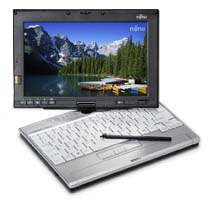|
Fujitsu LifeBook P1620
Updated tiny LifeBook pen-convertible
(by Conrad H. Blickenstorfer)
 Fujitsu has a long history of offering tiny little pen-enabled notebook(let)s that are intriguing alternatives to larger, heavier laptops, especially for those who spend a lot of time on the road. The latest iteration, the LifeBook P1620, is an update to the original LifeBook P1610. The P1620 was introduced in January of 2008 and is truly tiny with a footprint of just 9.15 x 6.6 inches. It's also just over an inch thick and weighs next to nothing (2.2 pounds).
Fujitsu has a long history of offering tiny little pen-enabled notebook(let)s that are intriguing alternatives to larger, heavier laptops, especially for those who spend a lot of time on the road. The latest iteration, the LifeBook P1620, is an update to the original LifeBook P1610. The P1620 was introduced in January of 2008 and is truly tiny with a footprint of just 9.15 x 6.6 inches. It's also just over an inch thick and weighs next to nothing (2.2 pounds).
Small size, however, doesn't mean inadequate specs. While the P1610 was perhaps a bit underpowered with a Core Solo processor, the new P1620 has a 1.2GHz Ultra Low Voltage Intel Core 2 Duo processor. It uses the Intel 945GMS chipset. Base RAM is half a gig, but you're better off using the sole Micro-DIMM slot for a 2GB chip if you plan on using the Vista Business Edition. The hard disk range has been updated and you can get shockmounted disks from 40 to 100GB, or -- new -- a 32GB Solid State Disk. On the wireless side, you have a choice between Atheros Super AG or the Intel Wireless WiFi Link 4965AG modules, both new. You can also order the P1620 with Windows XP Professional or the XP Tablet PC Edition 2005. Security us addressed via a Trusted Platform Module, a built-in biometric Fingerprint Sensor, and accompanying software.
Note that the P1620, while it can be converted into a tablet slate, has a passive digitizer and not a Wacom-style active one with cursor tracking. In fact, this computer is so tiny that it simply has to make some concessions, but Fujitsu's designers tried hard to make it up to customers with nifty extra features. For example, while the display measures just 8.9 inches diagonally, it is a rather high resolution 1280 x 768 15:9 aspect ratio LCD -- and that's a lot of pixels for such a small screen. Also, unlike almost all Tablet PCs that use the swivel display hinge, the 1620P's goes both ways. And while the standard 3-cell battery offers only acceptable battery life in the 3+ hour range, you can replace it with a 6-cell extended battery that packs twice the punch, but adds barely anything to size and weight.
We usually don't like scaled-down keyboards, but in this day and age of thumbtype keyboards, and also given the P1620's tiny size, the 16mm key pitch is acceptable.
Base price rose from US$1,599 to 1,749, and fully equipped models can go much higher. You always pay a bit more ultra-light computers.
|
|
|
|
Specifications Fujitsu LifeBook P1620
|
|
Added/changed
|
Added 01/2008
|
|
Form-factor
|
Pen-enabled Notebook
|
|
OS
|
Windows XP, Tablet PC Edition 2005, Vista Business
|
|
Processor
|
Intel Core 2 Duo U7600
|
CPU Speed
|
1.20 GHz, 533 MHz FSB
|
|
Chipset
|
Intel 945GMS and Graphics Media Accelerator 950
|
Standard/Max RAM
|
512MB/2048MB DDR2 in one Micro-DIMM slot
|
Disk/drive
|
Shock-mounted 40, 60, 80 or 100GB 4200 rpm P-ATA 100, or 32GB Solid State Drive
|
Card slots
|
1 PC Card Type II, 1 SD Card
|
Display type
|
Transmissive indoor/outdoor TFT
|
Display size/res
|
8.9-inch/1280x768
|
Digitizer/pens
|
Passive digitizer/1
|
Keyboard/scale
|
82-key integrated, 16mm pitch
|
Ruggedness
|
Standard
|
Housing
|
Unknown
|
Size (WxHxD)
|
9.15 x 6.6 x 1.36
|
Weight
|
2.2 lbs. with 28 WHr battery, 2.5 lbs. with 56 Whr battery
|
Power
|
3-cell 28 WHr Li-Ion ("up to 3.25 hrs"); 6-cell 56 WHr ("up to 7 hrs")
|
Interface
|
2 USB 2.0, RJ11, RJ45, dock, fingerprint sensor
|
Interface
|
Bluetooth (opt.), audio, Atheros 802.11a/b/g or Intel WiFi Link 4965AG, video
|
List price
|
from US$1,499
|
Website
|
Fujitsu
|
|
|
Search
|
|
|
|



